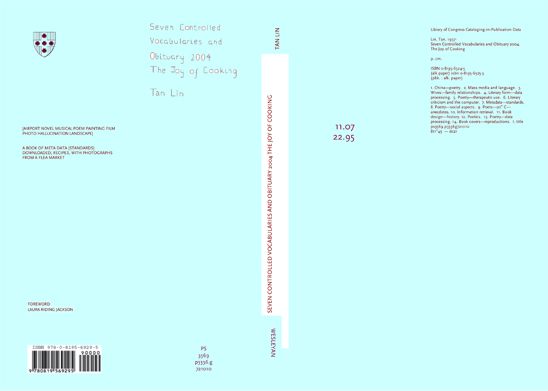Tan Lin: titling matter
Interview with Tan Lin for BOMB‘s website
Read the full interview here.
Katherine Elaine Sanders: The first thing I noticed about Seven Controlled Vocabularies and Obituary 2004. The Joy of Cooking was that the title appears on the back cover instead of the front. In the section of the book titled “American Architecture Meta Data Containers,” you write, “The front of a book is always less interesting than the back of a book.” Obviously you are interested in bringing the paratext, or material surrounding the text, to the fore, especially since the back of a book reveals the bar code and other labels of classification discussed within the book itself. Can you talk about this decision, and what interests you about the backs of books?
Tan Lin: The titling matter is the most visible element of the book’s packaging as well as its metrics: marketing strategy, production/layout/publishing decisions, dissemination in catalogues and bookstores, and its reception. Not much of this was controlled by me. Different formats induce markedly different kinds of reading. I am interested in that moment when reading begins, and the different kinds of reading that take place in, around, on the back of, and inside of a book—in particular a poetry book published by a university press.
Reading is a kind of integrated software. Some of its functions are textual, some paratextual, some visual, although the line between these does not really exist in my mind. SCV is fundamentally an examination of that blurring. Some of the reading is clearly authored by me, some is machine algorithms or library systems, some is by others, as with the Barthes index or the Laura Riding foreword. The Object ID system, also in place, is Getty Institute software. Numerals are closely linked to the publishing industry and the origins of (alphanumeric) writing. The front cover reflects this, although the two numerals are also in code. A title was “drawn” by Clare Churchouse using MS Word’s line function and a mouse. So it became interesting for me to think of the robin’s-egg blue cover as equivalent to the inattentive, unformatted, partially handwritten, generic moments before one reads the book. A lot of the book has already been read long before we got to it. Context is more important than content.


